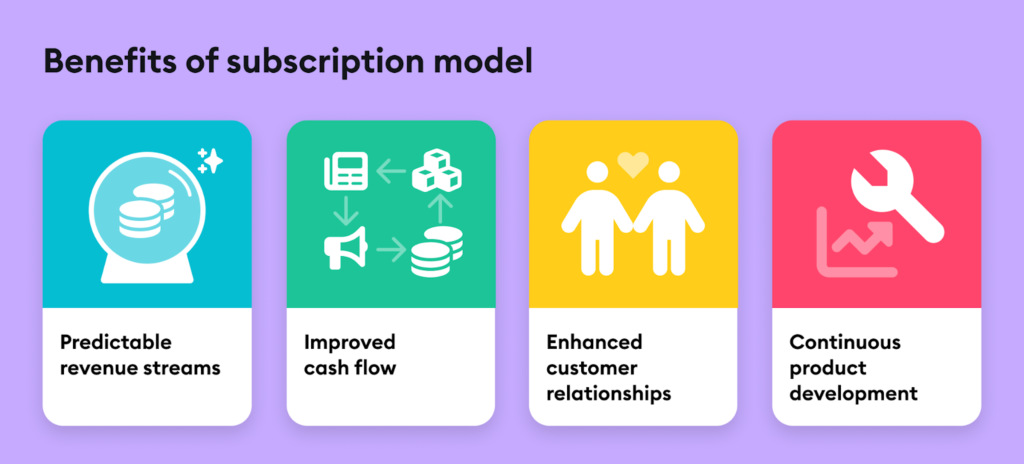Subscription-based businesses have reshaped the landscape of modern commerce, with industries from software to entertainment adopting this recurring revenue model. In this post, we’ll explore the key elements driving the rise of subscription-based business models, offering a deep dive into the benefits, challenges, and trends shaping the future of this business strategy.
Overview of Subscription-Based Business Models
Subscription business models are gaining immense popularity as companies transition from one-time sales to recurring revenue. By offering ongoing services or products for a monthly or annual fee, businesses create a continuous relationship with customers. The SaaS subscription model in the tech sector is a prime example, with companies like Adobe and Microsoft offering cloud-based solutions that rely on this model.

Key Benefits of Subscription Models
One of the major appeals of subscription-based businesses is the stability they bring. The recurring revenue business model ensures a predictable cash flow, allowing businesses to plan for growth more effectively. Lower customer acquisition costs and increased customer lifetime value add to the profitability of this approach.

Types of Subscription-Based Models
There are several kinds of subscription models that companies can adopt. Product-based models focus on delivering physical goods regularly, such as subscription boxes in e-commerce. On the other hand, the SaaS subscription model provides digital services like software or cloud storage. Another example is the membership business model, where access to exclusive content or services is granted for a recurring fee, common in media and online learning platforms.

Customer Retention and Loyalty
A crucial advantage of subscription business models is the ability to foster long-term customer loyalty. By continuously providing value, whether through exclusive perks, frequent updates, or personalized experiences, businesses can reduce churn rates and build lasting relationships. Companies that excel at retaining their customers often do so by offering tailored services, leveraging data insights, and keeping communication channels open with their subscribers.

Pricing Strategies for Subscription Models
Effective pricing strategies play a pivotal role in the success of any subscription model. Many businesses adopt freemium or free trial models to attract potential subscribers. Once users see the value, they are more likely to convert to a paid plan. Tiered pricing also allows companies to cater to different segments of the market, from budget-conscious consumers to those willing to pay for premium services.
The Role of Data in Subscription Businesses
The success of subscription models often hinges on data-driven decisions. Data collected from subscribers can be used to tailor the user experience, predict trends, and refine the offering. By using customer behavior analytics, businesses can deliver personalized content, improve user engagement, and develop more effective marketing campaigns. Data insights also play a critical role in identifying at-risk customers, allowing businesses to mitigate churn.
Continuous Value Delivery
One of the biggest challenges for subscription businesses is ensuring continuous value delivery. To keep subscribers engaged, companies must consistently offer new and improved features or products. Whether it’s monthly product updates, additional services, or bonus content, this ongoing innovation ensures customers feel they are getting value for their money, thus reducing the likelihood of cancellation.
Challenges of Subscription-Based Business Models
While subscription models offer stability, they also come with challenges. Managing subscription-based businesses requires a focus on reducing churn. If customers feel they aren’t receiving enough value, they may cancel their subscriptions. Additionally, keeping subscribers engaged and offering continuous value can be resource-intensive, requiring constant updates, customer service, and new features.
Trends Shaping Subscription-Based Models in 2024
As the subscription economy grows, several key trends are emerging. Personalization will continue to drive customer satisfaction, with businesses offering more tailored experiences to meet individual needs. Additionally, niche markets are growing, allowing smaller players to thrive in specialized sectors. Trends shaping subscription models also include flexible billing options and the use of artificial intelligence to enhance user engagement.
How to Implement a Subscription-Based Model in Your Business
Transitioning to a subscription-based business model requires careful planning. Businesses should first assess if their product or service can offer continuous value. Identifying a target audience and setting appropriate pricing tiers are essential steps. Businesses can then adopt subscription management software to automate billing, manage customer relationships, and monitor key metrics.
The Role of Technology in Subscription Success
Technology plays a vital role in scaling subscription businesses. Automation tools streamline billing, customer support, and marketing efforts. Additionally, CRM platforms help manage customer interactions, ensuring a seamless experience. The use of machine learning and AI can optimize pricing, offer personalized recommendations, and even predict churn, ensuring that companies maintain healthy customer retention rates.
Future Outlook of Subscription-Based Business Models
As consumer preferences evolve, the future of subscription business models looks bright. More industries will adopt recurring revenue models, offering consumers flexibility and business stability. Additionally, advancements in AI and data analytics will allow for even more personalized customer experiences. Looking ahead, the recurring revenue business model will continue to thrive, providing companies with the tools needed to foster customer loyalty and drive long-term growth.
By understanding the various components and trends of subscription-based businesses, companies can position themselves for success in this growing market. The rise of subscription models is not just a trend, but a fundamental shift in how businesses interact with customers, ensuring continuous engagement and revenue stability.






One thought on “The Rise of Subscription-Based Business Models”
Comments are closed.